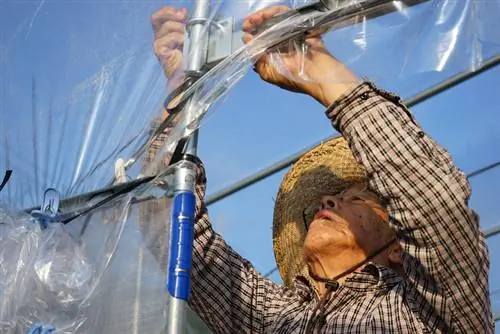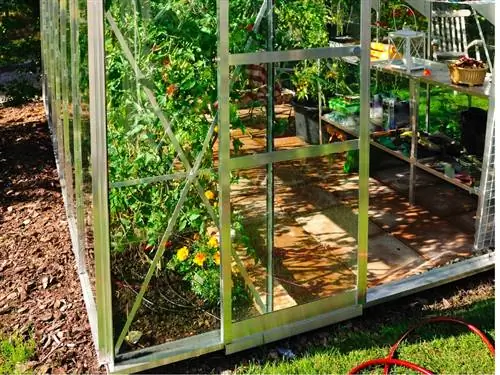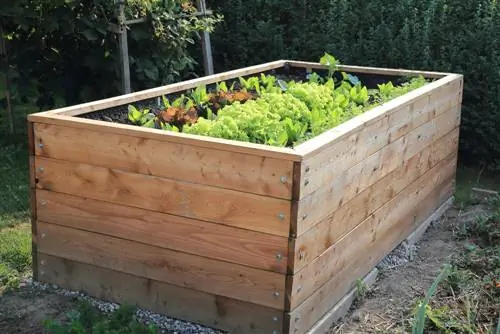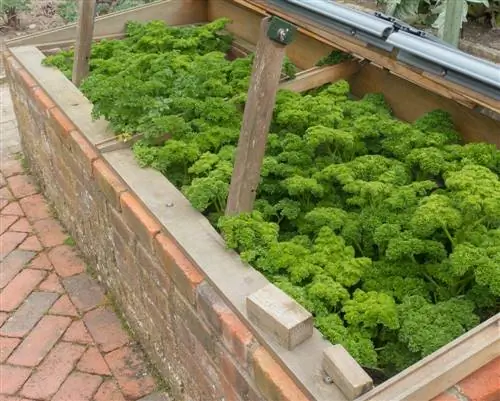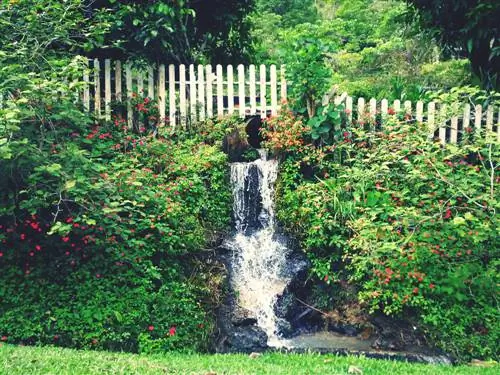- Author admin [email protected].
- Public 2023-12-16 16:46.
- Last modified 2025-06-01 06:02.
A good decision if you want to build your new greenhouse yourself and set it up as functionally as possible. In doing so, you will lay the foundation for your family's fundamentally he althy diet and will have a lot of fun successfully growing fruit and vegetable plants on your own.
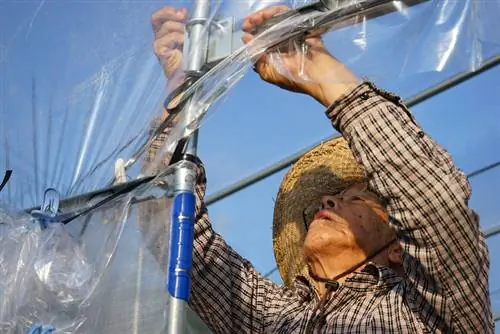
How can I build and set up a greenhouse myself?
Building a greenhouse yourself requires careful planning, selection of materials and accessories. The important steps include the choice of location, the decision for wooden, aluminum or plastic frames, the selection of the surface material, the foundation and the interior design as well as the furnishing with heating, ventilation, lighting and other accessories.
Gardening under glass, ideal for real organic food
The trend of growing fruit, vegetables and herbs for your own supply is constantly growing. This makes youindependent of industrially produced food, saves money and trips to the he alth food store and you enjoy the feeling of doing something good for your family and yourself. If you want to harvest particularly early and abundantly, you grow your crops under glass or foil and sooner or later come up with the idea that you could build a greenhouse yourself. The plants thrive better than under the often very unfavorable climatic conditions in our latitudes and it is fun to be able to almost watch them grow under glass.
The right location for your own greenhouse
The optimal place is exactly where there is as much direct sunlight as possible, all year round. The self-built greenhouse should, if possible,not be set up near larger trees, houses or other objects that cast shadows. In addition, it is advantageous if there is a water and electrical connection nearby and the new structure is protected from the wind but, since rainwater should be kept away as much as possible, not placed directly below a slope.
Build your own greenhouse - which material is the best?
Whether wood, aluminum or plastic is used for the supporting elements, i.e. the frame, is first and foremost a question of the financial budget and whetherthe entire greenhouse is built yourself or a pre-assembled kitpurchased and simply screwed together on site. The latter variant is particularly suitable for laypeople, as assembly is usually quite easy using the enclosed instructions. However, you will not be able to avoid creating a stable foundation, no matter how you want to build your own greenhouse. Let's first take a quick look at the three most common model variants.
Wood - the classic
Since the moisture load from outside (rainwater) and inside (air humidity) can be quite significant during certain weather periods, we recommendhigh-quality wood, for example larch or cedar. Building your own greenhouse with spruce or pine wood is a little cheaper. It is generally recommended that all wooden portals be thoroughly impregnated before assembly, which can significantly increase their service life.
For lightweight builders - greenhouse with aluminum frame
This variant is not only light in terms of material, but also in terms of assembly. However, aluminum does not have good insulating properties and quickly lets heat and cold into the interior. However, extreme temperatures and moisture do not harm the material itself. Aluminum greenhouses are extremely robust for many years and require almost no maintenance.
Plastic greenhouses - the robust ones
They look elegant with their plastic frame made of polypropylene and polyvinyl chloride and this material also provides excellent insulation. The greenhouse panes are usually made of solid-colored plastic, which allowseasy assemblywhen setting it up yourself. Another advantage is theLongevity, as there are hardly any signs of wear even after several years. If you build your own greenhouse and use plastic for it, the purchase price may be a little higher, but you won't have to put a lot of effort into maintaining it.
The surface material - the most important part of the greenhouse
Sure, because especially when used all year round, it needs optimal insulation, both against outside temperatures that are too high or too low, and all moving components must also be tightly closed. Light and UV rays should be able to penetrate well into the interior of the house, which enables dense and lush growth of the plants. Special coatings help ensure that anycondensation water that forms flows away evenly and prevents the formation of droplets at certain points. Since you want to build your new greenhouse yourself, the material must be as easy to process as possible, which could cause problems with the classic, blank glass.
Use glass on the plant house?
If you build everything yourself, you will quickly reach your limits when cutting glass as an inexperienced layperson. In addition, if you don't use old demolition windows that were purchased cheaply when building a new greenhouse, glass isquite expensive in storesHere is an example of the costs that we researched for you from an online retailer:
ESG safety glass clear with polished edge:
- 1,000 x 1,500 x 4 (mm width/height/thickness: 72.00 euros per piece
- 1,000 times 2,000 x 4 (mm width/height/thickness: 94.00 euros per piece
- 1,500 x 2,000 x 4 (mm width/height/thickness: 135.00 euros per piece
Optionally, the material can be ordered pre-drilled for later attachment. The prices for this:
- Two holes: 9.50 euros
- Four holes: 19.00 euros
- Six holes: 28, 50 euros
In the case of a binding order, a quantity discount would certainly be negotiable, which would have to be deducted from the prices mentioned above. Added to the total price are transport costs, which are rarely less than 50.00 euros.
Plastic panels - translucent and impact-resistant
In practice, hollow-wall panels made of polycarbonate have become established. They achievegood values for the transmittance of UV rays, are very easy to cut, but have the unpleasant property that they begin to yellow after ten years. Acrylic glass, on the other hand, remains color stable for 30 years, but can splinter more easily when cut. The last option left is PVC panels, which are also robust but also inexpensive if you build your own greenhouse. Small disadvantage: The light transmission is not quite as high as with the other two materials.
Foil as the cheapest alternative
Greenhouse films are made of polyethylene and are made in multiple layers. This gives them a certain tear resistance, but they are still less stable than glass or plastic panels. Special thermal films with air cushioning can still last for several years. Many allotment gardeners who build their own greenhouse appreciate theeasy and quick processing of films, use them especially for smaller houses and usually not all year round, but only to raise their seedlings and young plants Beginning of the gardening year.
Metal foundation frame vs. concrete base
Many prefabricated kits contain a more or less stable metal frame that can be driven directly into the ground using four anchors. This may well be enough for small houses that are only used for a few weeks in the spring. If you build a greenhouse yourself that is intended to be in use all year round and is over 10 m2 in size, you are on the safer side with asolid concrete foundation In addition to a not insignificant increase in stability With a high-quality foundation, subsequent energy consumption increases significantly. Please also note that most insurance companies only settle claims if it is a permanent outbuilding that stands on a solid foundation and is firmly anchored to it.
The thing with the building permit
An ongoing topic that has probably occupied generations of hobby gardeners who want to build their own greenhouse. Due to most state building regulationsno building permit is necessary for the kits offered in stores that are not used commerciallyas long as they neither have a lounge nor a fireplace. This is different with the ridge heights, which above a certain value could be reported but notrequiring approval In addition, it is possible that the municipal building use regulations prescribe boundary distances inside and outside of properties, for example that of the neighbor, so an informal visit to the community before building the greenhouse may make sense.
Inside raised bed or would you rather have a ground-level extension?
To answer this question, you must first be clear about which plants will later be planted in the finished greenhouse. Naturally, you should regularly replenish these intensively, sometimes one-sidedly used soilswith compost, nutrients and ideally with rotted cattle or horse manure, which can be quite physically demanding when cultivated at ground level. Briefly some advantages of raised beds:
- Since the main seed flight takes place above the ground, weeds grow less intensively in raised beds;
- Hardly any snail infestation; If a snail barrier is additionally installed, the animals stay away completely;
- More efficient use of the heat from decomposition, thereby improving the growth rate;
Planting at ground level needs a foundation
While raised beds naturally do not place such high demands on a proper and solid foundation, it is mandatory for ground-level cultivation in the interests of frost protection. Under certain circumstances, if you build your entire greenhouse yourself, aheating system may also need to be installedThe foundation should therefore have a minimum depth of 80 cm and be built as a solid strip foundation. In addition to overall greater stability, this also ensures that the entire construction is less exposed to soil moisture and will therefore have a longer service life.
How much does it all cost?
How high the financial investment will be cannot even begin to be said in general terms. There are, from the size to the later furnishingmany factors that may reduce your costs, but can also increase them Eight square meter lightweight foil buildings as a set are available from relevant mail order companies already offered for just over 200.00 euros. You can just as easily find one of the same size, but with a sturdy wooden construction and a rustic design for over 3,000.00 euros. Purely from experience, however, it can be said that building a greenhouse yourself can be more cost-effective, but in any case more individual and more interesting in terms of construction and architecture.
Plan greenhouse accessories into the costs
ABasic set of certain accessories should be included in the planning from the outset, especially if you build the entire greenhouse yourself and procure the necessary materials yourself. The shopping list could then look something like this:
| Accessories | Use for | Average cost |
|---|---|---|
| Gas or petroleum heating | Warmth in winter | 100 to 150 euros |
| Fan | Air exchange, against mold | 60 to 100 euros |
| Irrigation system | Watering, climate regulation | 50 to 80 euros |
| Lighting equipment | Growth support on dark days | 50 to 150 euros |
| Shading Fabric | Protection against overheating | 40 to 80 euros |
| Shelves and tables | Placing plants | 50 to 150 euros |
| Thermometer, hygrometer | Indoor climate monitoring | 30 to 60 euros |
Tip
Building and setting up a greenhouse yourself means taking many eventualities into account. Even during the planning stage, it is important to ensure that everything is done to prevent futuremold infestation within this microclimate High-quality material is better suited to this than any cheap set from the surplus store next door.

